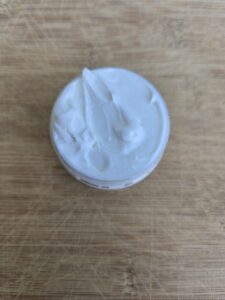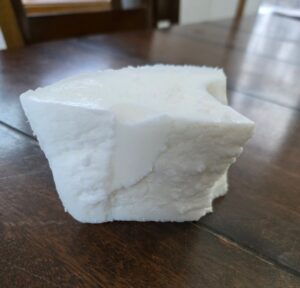Using tallow, or animal fat, on your skin is an ancient practice that is regaining popularity today. Discover why tallow is all the rage right now as a moisturizer for the face and body. Tallow’s composition, uses, and unique benefits are discussed.

This post contains affiliate links. As an Amazon Associate, I earn from qualifying purchases.
The use of tallow in skincare products has grown in popularity recently… and for good reason! Tallow has many benefits and can help nurture and protect even the most sensitive skin.
Here are a few reasons this is one trend you will be happy that you decided to try!
What is Tallow?
Simply put, tallow is animal fat. Tallow comes from animals that are considered ruminants, with a four-chambered stomach that chew cud. Ruminants include cattle, goats, sheep, and deer.
Tallow is made by rendering suet. Suet is the fat that can be harvested from around the animal’s kidneys and loin. Rendering is a process whereby the raw fat is purified and strained to remove skin, muscle, connective tissue, and foreign material.
Uses of Tallow
Tallow is edible and can be used like other fats for cooking and frying food. It can also be used for soap or candle making and in skincare products such as lip balms and body butters.
For more on rendering techniques, follow the links to find out how we wet or dry render our tallow for making balms. For our tallow and beeswax lip balm recipe, click here. Directions to make your own solid or whipped tallow balm can be found in our related articles.
Let’s look at what’s so great about using tallow in skincare!
1. Tallow is Biocompatible with Human Skin
Tallow is entirely made up of fatty acids including the saturated fatty acids palmitic, stearic, and myristic acid. It also contains the monounsaturated fatty acids oleic and palmitoleic acid and polyunsaturated fatty acids linoleic and linolenic acid.
Tallow has a similar fatty acid profile to our own skin oils and therefore is nonirritating and biocompatible when applied to the skin’s surface.
2. Tallow is Extremely Moisturizing
Tallow is viscous and a little bit goes a long way. A thin layer of tallow can help keep your skin moisturized for hours.
Dermatitis or dry, scaly skin caused by weather or over-cleansing can be effectively managed by the periodic application of tallow-based skincare products that simultaneously hydrate and protect the skin.
3. Tallow Enhances Your Skin’s Protective Barrier
Your skin cells and natural oils provide a barrier between your body and the outside world. Your skin keeps moisture in and environmental pollutants out. The natural acidity of your skin helps protect your body from bacterial, viral, or fungal overgrowth.
Tallow has a similar pH to healthy skin and can help enhance your skin’s protective barrier. Applying tallow is like adding another layer of skin!
4. Tallow Provides Your Skin with Fat-Soluble Vitamins
Tallow contains fat-soluble vitamins like Vitamin A, D, E, and K. These vitamins have antioxidant properties that help protect the skin from free radicals.
When applied to the skin, tallow can help repair damage and reduce irritation, making your skin feel more smooth, firm, hydrated, and elastic.
5. Tallow is a Natural Skincare Option
If you are looking for a natural alternative for skincare, tallow is a great option with a long history of use. People have been using animal fat for centuries to moisturize and protect their skin.
Tallow skincare should be free of fillers, additives, or synthetic ingredients. When prepared appropriately, tallow is shelf-stable and does not require a preservative.
If you want clean skincare, with minimal ingredients, tallow is the way to go. It can be used alone, or whipped with a liquid oil like olive, castor, or avocado for easier application. It can be scented with essential oils or phthalate-free fragrance to cover the mild earthy, natural smell.
6. Tallow Use Supports Responsible Agriculture
Tallow is considered a byproduct of the meat production industry. Using the animal’s fat, that otherwise may go to waste, is a way to practice and support responsible agriculture.
Depending on the way that the animals were raised, tallow has the potential to also be a more sustainable option with a positive environmental impact compared to farming practices associated with plant-based oils.

References:
Kendall, A.C. & Nicolaou, A. (2012). Bioactive lipid mediators in skin inflammation and immunity. Progress in Lipid Research, 52(1), 141-164. doi: 10.1016/j.plipres.2012.10.003.
Russell, M.F., Sandhu, M., Vail, M., Haran, C., Batool, U., & Leo, J. (2024). Tallow, rendered animal fat, and its biocompatibility with skin: A scoping review. Cureus, 16(5), e60981. doi: 10.7759/cureus.60981.

Mother, farmer, author, and teacher by trade… She loves tending to things and watching them grow!
